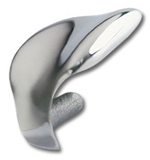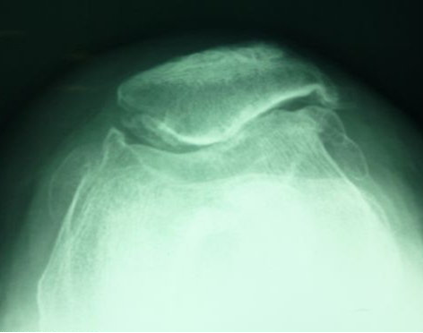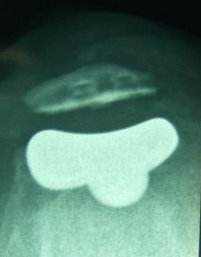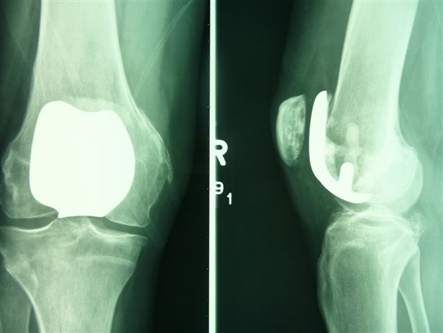 Patellofemoral Joint
Patellofemoral JointReplacement
If your stiff, creaky knee joints make it difficult to move, climb stairs or even sit still without pain, you may be suffering from kneecap osteoarthritis. If the pain centers around your kneecaps or the front of your knee, schedule an appointment with Dr. Likover to determine whether you’re a candidate for patellofemoral joint replacement surgery.
Severe knee pain in the front of the knee is commonly caused by patellofemoral arthritis. The good news is you can repair this affected joint without replacing your entire knee.
Table of Contents
- Anatomy of the Knee
- What Is Osteoarthritis?
- What is Patellofemoral Joint Replacement?
- Diagnosing Patellofemoral Arthritis
- Candidates for Kneecap Replacement
- Patellofemoral Implants
- Patellofemoral Arthritis Symptoms
- Patella Replacement Surgery Recovery
- Patellofemoral Joint Replacement Images
- Schedule an Appointment
Anatomy of the Knee
To understand how osteoarthritis causes your kneecaps to ache, let’s look briefly at the anatomy of the knee.
Three bones make up the knee: the tibia, femur, and patella. There are three places in the knee, called compartments, where these bones come together. They are:
- The medial femorotibial compartment (inside compartment);
- The lateral femorotibial compartment (outside compartment); and
- The patellofemoral compartment (anterior compartment).
When you bend your knee, the patella (kneecap) glides up and down within a groove in your femur (thigh bone) called the trochlea. The articular cartilage in this area helps minimize friction when your knee is bent so you can move freely and without pain.
What Is Osteoarthritis?
Osteoarthritis is a degenerative joint disease that can cause the articular cartilage to wear away, causing painful friction when you move your joints. Age is one of the leading causes of osteoarthritis, but it can also be caused or worsened by joint injuries. The knee is among the most common joints affected by osteoarthritis.
However, osteoarthritis often affects individual knee compartments, leaving the other cartilage in your knee healthy and fully functional. If you suffer from patellofemoral arthritis, patellofemoral (kneecap) replacement surgery may be a solution for relieving pain and restoring your normal range of movement.
What is Patellofemoral Joint Replacement?
Patellofemoral joint replacement is a type of partial knee replacement that allows you to correct the damaged knee joint while preserving the healthy parts of your knee. Because this surgery only treats the patellofemoral compartment, it is also known as a unicompartmental or partial knee replacement. The primary reason to do this operation is to alleviate persisting and substantial pain.
Diagnosing Patellofemoral Arthritis
Patellofemoral arthritis is diagnosed by examining a person’s weight-bearing and sunrise x-rays (taken with the knee flexed). If the weight-bearing tibiofemoral joint is normal, this person might be a good candidate for a partial knee replacement of the patellofemoral joint. Below, you will find x-rays from real patients suffering from patellofemoral arthritis. These patients exhibited advanced deterioration of the kneecap cartilage, with the rest of the knee remaining healthy.
Candidates for Kneecap Replacement
The primary and classic use of this implant is for isolated patellofemoral arthritis (kneecap joint arthritis) when the rest of the knee joint is in good shape. However, patellofemoral joint replacement is often recommended for younger persons with certain cases of advanced chondromalacia of the patellofemoral joint not responsive to other surgical procedures.
This means the person has failed at least one arthroscopic lateral release, and possibly failed a micro-fracture or OATS (osteochondral autograft transfer system) procedure. In these cases, the x-rays are usually normal with arthroscopic evidence of loss of articular cartilage in the patellofemoral joint.
Patellofemoral Implants
Fortunately, the newer kneecap implants Dr. Likover uses have been shown to have an indefinite life expectancy, making this implant suitable for younger persons thirty and up.
The reason that this implant has a long life span is that it does not bear substantial weight during knee motion and is, therefore, not under a lot of mechanical stress.
Patellofemoral Arthritis Symptoms
A person requiring patellofemoral joint replacement may experience pain when doing the following activities:
- going up and down stairs
- squatting
- getting up from a chair
- bending and straightening the knee against resistance
- walking
Patella Replacement Surgery Recovery
A kneecap joint replacement is a much smaller operation than a total knee replacement. The incision is much smaller and all knee ligaments are preserved. Recovery from a patellofemoral joint replacement is thus the quickest of all partial knee replacement recoveries.
It may take up to three months for your knee to heal fully after surgery. However, you should be healed enough to begin driving again within two weeks. Most patients may return to work within six to eight weeks.
Visit our knee replacement recovery timeline page for more information about recovering after your surgery.
Patellofemoral Joint Replacement Images
Severe Patellofemoral Arthritis Before Surgery
The x-ray image below shows a patient with severe patellofemoral arthritis before surgery. The patient’s articular knee cartilage has degraded and worn so thin that the bones have begun scraping against one another. This causes extreme pain and limits their mobility. This is “bone on bone” kneecap joint.

Patellofemoral Joint Replacement Post-Op X-Ray Images: Top, Front, and Side Views
The following photos depict top, front, and side x-ray views of the same patient’s knee after patellofemoral arthroplasty. The artificial kneecap has been implanted, providing relief from the bone-on-bone scraping and allowing the knee to move more fluidly with substantial pain reduction.


Patellofemoral Arthritis (Kneecap Arthritis) – Case #1
These photos were taken during kneecap replacement surgery. The 47-year old female patient presented an advanced case of osteoarthritis in the patellofemoral joint. You can see where her cartilage has worn away on both the femoral trochlea and patella (kneecap). This patient was an ideal candidate for patellofemoral arthroplasty.
Patellofemoral Arthritis (Kneecap Arthritis) – Case #2
This patient suffered from severe osteoarthritis of the knee. This photo, taken during a patellofemoral knee replacement procedure, shows the extent of cartilage damage on the patella. The ridging on the underside of the kneecap negatively impacted the patient’s natural knee kinematics.
Patellofemoral Replacement (Kneecap Joint)
This surgery photo depicts the patellofemoral implant in place on the patient’s knee. Both the femur and kneecap have been resurfaced.
Schedule an Appointment with a Leading Orthopedic Surgeon
Dr. Likover is an expert orthopedic surgeon who has practiced for nearly four decades in Houston. He has successfully treated a wide range of knee conditions, including patellofemoral arthritis.
Dr. Likover will examine your knees to determine whether you suffer from isolated patellofemoral arthritis. If you are only experiencing pain in your kneecaps, he can repair the affected joint – you may not need a total knee replacement.
Submit an online form or call his office at 713-465-0696 to schedule an appointment with Dr. Likover today.

 Dr. Larry Likover has been practicing orthopedics on the west side of Houston for 43 years, treating knee, hip, shoulder, and back problems. Dr. Likover is board certified in orthopedic surgery and provides knee replacement in Houston for patients worldwide.
Dr. Larry Likover has been practicing orthopedics on the west side of Houston for 43 years, treating knee, hip, shoulder, and back problems. Dr. Likover is board certified in orthopedic surgery and provides knee replacement in Houston for patients worldwide.